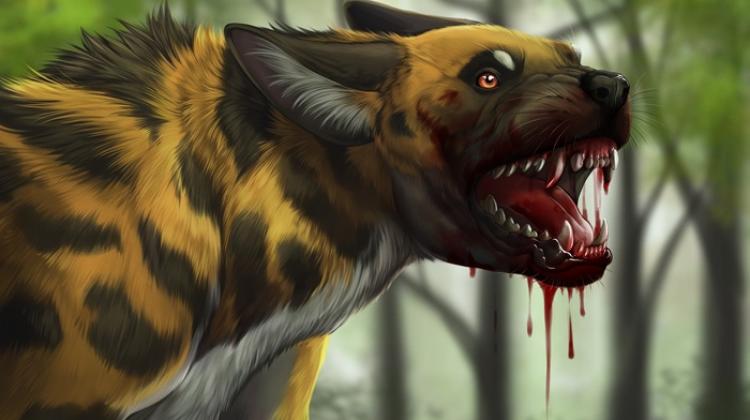
Eurasian Lycaon lycaonoides after a successful hunt. Powerful dentition visible. Graphic: W. Gornig after https://naukawpolsce.pl/
“Canine Jack The Ripper” under the supervision of our scientists
We are familiar with Lycaon from Africa, but around half a million years ago, these predatory mammals also inhabited the territory of present-day Poland. Scientists from the University of Wrocław, who examined the remains of the last Eurasian Lycaon from the Wieluń Jurassic system, refer to it as “Psi Kuba Rozpruwacz” (Canine Jack the Ripper). It was capable of bringing down a very large prey and consuming its flesh whole.
Located in southern Poland, stretching between Wieluń and Częstochowa, the Wieluń Jurassic system is an area that is incredibly picturesque but still relatively unexplored in terms of paleontology, despite its enormous potential and richness. “It is ideal for paleontological and speleological expeditions, as well as various physical activities” – notes dr. hab. Adrian Marciszak, a professor at the University of Wrocław and head of the Department of Evolutionary Biology and Vertebrate Conservation at the Faculty of Biological Sciences. As I read in Nauka w Polsce (“Science in Poland”), it is precisely in the Wieluń Jurassic system, about 6 km southwest of the town of Działoszyn (Łódź Voivodeship), where scientists have identified a site called Draba 3, which contains the remains of the Eurasian Lycaon. It was there that the last, relict occurrence of this species in the territory of present-day Poland was found. An article was dedicated to it in Quaternary International. The co-authors of the publication are Wiktoria Gornig from the University of Wrocław and Adam Szynkiewicz from KART-GEO in Wrocław.
“Dogs of the genus Lycaon appeared in Europe around 2.6 million years ago, and their morphology remained almost unchanged for the next 2 million years” – reminds prof. Marciszak. He adds that over the next 2 million years in Eurasia, the presence of a pair of large canids was well-documented: the large Lycaon and the smaller Mosbach wolf (Canis etruscus/mosbachensis). Of these two species, the long-legged Lycaon was significantly larger and dominated on open plains.
“The Lycaon likely had a negative impact on the wolf population” – notes the UWr professor. “The more numerous but smaller wolf could have been killed or driven away from prey by the larger Lycaon, as larger canids usually dominate over smaller species. Where larger canids are present, smaller species may modify their distribution, behavior, and pack size to limit interspecies competition or aggression. Additionally, the abundance of smaller dogs may be reduced compared to areas without larger dogs” – he wrote for the Nauka w Polsce website.
The Eurasian Lycaon (Lycaon falconeri/lycaonoides) was morphologically similar to the modern African wild dog (Lycaon pictus), but on average twice as heavy and more robustly built. Its great size, surpassing that of the largest modern wolves, was an undeniable attribute in hunting. It hunted similarly to the wolf, persistently chasing prey in packs and then literally eviscerating the prey. Its powerful dentition with strongly developed cutting edges and massive jaws were ideal for this task. This highly effective method, involving an attack on the vulnerable, soft abdomen, caused the prey to die within minutes due to shock and blood loss. “Often, the defending hooves or antlers of the prey would cause it to die even faster, as attempting to strike one attacker unsuccessfully exposed it to the attack of the others”, the scientist reports.
According to the researchers’ analysis, the Lycaon occupied a “peculiar ecological niche, not reflected in any contemporary species”. It was able to bring down a very large prey, and its body was consumed whole thanks to its exceptionally strong jaws and dentition.
“The Eurasian Lycaon was a member of a fairly stable lineage of predatory mammals, among which it held one of the dominant positions” – explains prof. Marciszak.
“The discovery itself, as well as research in the Wieluń Jurassic system, is the result of many years of cooperation between myself and employees of the Department of Paleozoology with a retired UWr employee and excellent geologist, dr Adam Szynkiewicz, who is still professionally and scientifically active” – prof. Marciszak told us. “Without his scientific support and knowledge of local geological conditions and site locations, it would be difficult, if not impossible.”
The site itself is actually a complex of 9 sites, constituting an extensive, collapsed cave system, later filled with sediments. “It has great research potential, so currently, together with archaeologists from UWr, we are conducting exploratory research there. Because the Lycaon and fauna are not the only surprise that Site Draba 3 holds” – the professor says mysteriously. “And interestingly, a significant portion of the bones was not discovered at the site, but was previously excavated, but improperly labeled.”
Generally, the Wieluń Jurassic system is somewhat forgotten in terms of paleontology, but it has enormous research potential, which we will certainly inform about. It is also a beautiful area for active recreation or simply spending time away from the daily hustle and bustle.
The fauna itself is unique in that it includes both very old species, such as the Eurasian Lycaon, jaguar, or saber-toothed cat, as well as a whole range of forms that will create the basis of the fauna after the disappearance of the old fauna. “It is one of those Eurasian sites that documents faunal exchange in its spectacular form, involving top predators” – says the UWr Professor.
We encourage you to read the article on the Nauka w Polsce website.
prepared by Katarzyna Górowicz Maćkiewicz
Translated by Oliwia Kowalińska (student of English Studies at the University of Wrocław) as part of the translation practice.



